
8 Releasing into Movement from the Center of Being
How is it possible to be in the world without getting uprooted from my center?
THE INTERPLAY BETWEEN BEING AND DOING has been a subject of inquiry since human beings have been stirred by intuitions of an ultimate consciousness. On the side of merging into pure “beingness,” some have embodied the yogic ideal as an austere withdrawal from sensorial stimulation in favor of making a solitary journey into the interior of one’s own experience. On the side of doing, others have embodied the spirit of yoga as dedication to selfless service in the world. At the heart of both poles in this paradox lies the intention to realize one’s capacity to use experience, be it internal or external, as an opportunity to awaken to inherent wholeness as the essence of one’s true nature.
In an ancient yoga sutra we catch a glimpse of how yogic practice aims to address this paradox at the heart of human experience. The sutra states: “Although she moves, she is ever still.”
Self-Awakening Yoga takes its inspiration from the As Is principle—Awareness of Sensation through Internal Scanning. In becoming aware of our bodily felt experience, our experience at the level of sensation, we begin to ground awareness in the concrete, in the present moment. The body lives in the present, while the mind is free to travel throughout multidimensional time. From this bodily anchor in physical reality, other layers of the self become revealed. Awareness of sensation expands to include awareness of prana, the subtler energy movements in the body. Noticing how the energy of prana can be directed by mind, we become aware that on some level we are participants in the creation of events in our world. Where the mind goes, prana flows. Studying how and why we create what we create reveals a personality at work, an ego that is structured to avoid pain and to seek pleasure. Studying the cause-and-effect relationship of the choices we make begins to open a deeper capacity for fulfillment, a dimension of being beyond wanting, getting, and having. We start to notice that fulfilling our own needs has an impact on others. Taking responsibility for our actions engages the witness, that aspect of our being that operates from discriminative wisdom. In the climate of radical self-acceptance for the survival functions that our egos fulfill, we begin to awaken to deeper levels of choice in our lives.
A sense of bliss emerges when we follow the discriminating wisdom that arises from witnessing our lives, our choices, and our creative possibilities. This bliss is not necessarily a constant euphoric or utopian jubilation but a calm and quiet sense of harmony in the midst of paradoxical circumstances that are constantly and unpredictably changing. Yogis say that it is possible to remain in radical self-acceptance of the many dimensions of our experience amid the unruly events of life. This radical self-acceptance is described as a lotus blossom. The unfolding flower of consciousness is rooted deep in the mud of life.
Swami Kripalu described the intentions of yoga in a slightly different manner. “When a yogi is lying down, the yogi is lying down. When a yogi is sitting, the yogi is sitting. When the yogi is standing, the yogi is standing. When the yogi is walking, the yogi is walking.” In other words, when you are lying on the ground in the supine position in the midst of an inquiry into the sensations of heaviness, you are not using the quiet time to think about the shopping you have to do for tonight’s dinner. Later, when you are in the grocery store shopping for your family, you are not wishing you were lying on the floor doing your yoga inquiries.
Self-Awakening Yoga provides access to the actual experiences that arise on the screen of consciousness from moment to moment. This includes the moments that we notice ourselves being projected into a hundred other future or past moments. Noticing that our awareness travels throughout many dimensions and accepting that phenomenon is the doorway for returning to the actual experiences in this moment. Being who we are as we are opens a doorway for accessing deeper levels of choice and possibility.
Jesus taught his followers to “be in the world, but not of the world.” Yogi Patanjali describes the possibility of witnessing our experience without being identified with it. With our lives already being lived in full progress, how do we begin to return to an internal center from which we can cultivate a witness perspective? How do you recognize your internal center?
Let’s begin with some more concrete questions that might lead to an answer to the ultimate inquiry here. As you deepen into your practice of Self-Awakening Yoga, do you notice a developing sense of confidence in your ability to get interested in your actual experiences? With permission to witness and to learn through your experience, have you noticed a lighthearted sense of humor beginning to supplant self-criticism or seriousness? Do you hear yourself beginning to say, “Isn’t that interesting?” Is fascination and curiosity about your experiences opening windows to possibility where apathy and indifference or boredom might have won out at other times in your life? Can you sense the presence of novel responses emerging in the place of previously habitual reactions to circumstances? As you begin to acknowledge these qualities in your yoga practice and your life practice, you can recognize that your sense of living at home in your center of being is beginning to crystallize.
You may notice that the inquiries up to now have already begun to open this witnessing capacity. The inquiries in this chapter provide an opportunity to experience how you can move in every direction while staying rooted in your center. As this awareness of your center develops, you are creating the means to return home into this core whenever you feel yourself drifting away from yourself. You will notice that in postures such as Triangle, Rotated Triangle, Half Moon, and Standing Warrior Twist—postures in which the body is extending in several directions at once—your ability to stay grounded will be enhanced with the awareness of remaining in contact with and moving from your center.
Moving from the Center
Inquiry: How does freeing prana in the sacrum encourage free-flowing movement from the center?
Have you ever wondered how the sacrum got its name? First, let’s locate the sacral bone. The sacrum is actually five vertebrae that are fused together; the sacrum is located at the base of the spine. When you bring your palm to the base of your spine with your middle finger pointing down toward the tailbone, the heel of your hand will be positioned near the top of the triangular-shaped sacrum, which points downward. At the bottom of the sacrum is the coccyx, the tailbone. Although the tailbone is attached to the sacrum by dense cartilage, it retains some movement possibilities. The sacrum is stabilized on either side by the hip bones, the ilium—bones that fan outward like elephant ears.
The sacrum is designed to move in the hip girdle, although in many adults one or both of the sacroiliac joints, where the sacrum articulates with the hip bones, are fixed in place. The loss of movement in these joints shows up in yoga postures as limitations in forward bending or in “sidedness”—when it is easier to stand, balance, or initiate spinal twists on one side than the other.
Loss of movement at these joints occurs for many different reasons, with injury from a fall being the most common. We don’t notice that soreness after a fall will sometimes linger, causing a preference to bear more weight on one side of the body in order to protect the injury. While the injury is in the process of healing the sacrum glides over to fixate on the protected side, leaving the supporting side to do all the work of articulating. Lifestyle habits create other reasons for the sacrum fixating to one side or the other. Have you ever held a baby in one arm with a telephone at your shoulder while you stirred dinner with the other arm? In these kinds of daily movement patterns, the load-bearing side arranges itself to support the body while the other side is left free for movement articulation. What about shifting your weight onto one leg while waiting for the bus? Or sitting at a computer and using one hand to manipulate the mouse while the other hand rests? All such movement habits and preferences create bilateral imbalances that begin to show up in the sacrum.
Now, why is this bone called the sacrum? The name comes from the word sacred, or the “sacred bone.” In yogic philosophy this bone is considered sacred because it contains the energy of our evolutionary potential. Think for a moment about how humans evolved from locomoting on four legs to standing and walking on two legs. The five fused bones comprising the sacrum are the vestigial remains of a long tail that used to be an essential appendage for hanging in trees, counterbalancing a trot or gallop, or signaling sexual availability. The evolutionary need for the tail has withdrawn to a potent distillation of energy that is housed in the coccygeal nerve plexus. Yogis identify a latent, concentrated form of prana that lies dormant in the sacrum that, when awakened, travels up through the spine and opens the higher centers of human and divine consciousness. Called the kundalini, many of the traditional yoga practices are designed to awaken and channel this energy for the conscious evolution of the whole person. In Self-Awakening Yoga we are gently knocking on the doorway of this sacred bone, awakening the concentrated energy of prana so that it may flow more freely throughout the physical body, enhancing the functioning of all systems.
In the Sacrum Release below, you will discover a simple and pleasurable way to restore movement in the sacrum. Reach and Roll allows you to use this freedom of movement as a fulcrum for rolling your body from side to side. The movement builds into a spiral that carries you right up into our first seated postures. Moving in this way allows you to access the seated postures, such as Butterfly, Pinwheel, and Half Lotus, with greater balance between the two sides and greater flexibility in the hip joints.
Exploration 1: Sacrum Release
1. You may want a little extra padding for the explorations in this inquiry, as you will be rolling on the ground. Come to a comfortable position lying on the ground (fig. 8.1). As you begin to settle, making all the adjustments that support your comfort, begin to scan the many dimensions of your present moment. Notice the contact your body makes with the ground, witnessing any physical sensations that call your attention. Imagine that you are checking in with your body, as you would check in with a good friend, becoming interested in whatever you begin to notice.

2. Become aware of your breath and breathing, noticing how your body moves in response to your breath. Notice how quickly and deeply your body begins to relax as you attune to the sound and the sensation of your breathing. As you sense the speed and momentum of your thoughts and thinking, notice any particular thoughts that may be present for you in this moment. Appreciate your logical mind for participating in this inquiry as witness to your experience.
3. Attuning to the pulse deep in the center of your belly, notice your mood; notice the texture, color, and shape of any feelings or emotions that are present. Suggest to yourself that it is safe, desirable, and pleasurable to expand your awareness to include all of your feelings, all dimensions of your actual experience.
4. Imagine what you might have felt as an infant, lying on your back and exploring the sensations of reaching with your fingers and toes, your arms and legs. What are the sounds and the movements your organism makes as you play?
5. Bend both knees and bring them over your torso. Grasp the knob of your right knee with your right hand, your left knee with your left hand (fig. 8.2). Throughout this exploration, your hands will be in continuous contact with the knobs of your knees. The more you use your hands to support your knees, the more your legs will have permission to relax into their own heaviness. As your hold your knees, how much of the weight of your legs can you release into the support of your hands? How are you breathing? Can you feel how your low back is elongated on the ground? Make the “yes” movement by rocking the back of your head on the ground and release your head in the neutral position.


6. Tie an imaginary string around your ankles, keeping the ankles in close contact. Holding on to your knees firmly and keeping the ankles together, roll over onto your right side. Keep your knees stacked one on top of the other and bent, as though you were sitting on a stool (fig. 8.3). Without letting go of your knees with your hands or letting the ankles come apart, explore the sensations of being in this position. What feels comfortable and what feels uncomfortable about the position? Particularly notice the position of your head relative to your right shoulder. Does it rest comfortably or awkwardly on the shoulder?
7. Keeping the ankles stacked one on top of the other and maintaining a firm grip on the knobs of your knees, you are going to begin a subtle movement in which the left leg slides out toward the floor over the right leg (fig. 8.4). The tendency will be to let the ankles come apart or to lift the left (upper) leg, but you want to contain the movement to what you can do with the ankles remaining in contact. Slide the left knee out and drag it back, experiencing the inner thighs moving against each other. Start the movement slow and small; as it begins to feel familiar and comfortable, let the sliding gradually get bigger. If you allow your head to get involved, it will start to roll back and forth over the bump of your right shoulder in response to the pivoting that is occurring in your hips. Notice how the sacrum, the triangle-shaped bone at the base of your spine, pivots between the hip bones.
8. When the movement becomes freer, your head will roll forward as the left knee slides out toward the floor. You can tuck your chin slightly and allow your head to roll all the way under to see behind your body (fig. 8.5). When you drag the left knee back the head will roll again, this time to see all the way over your left shoulder (fig. 8.6). When your head begins to roll from side to side with greater range of motion, you will experience how the left ear can come close to the ground on each side.
9. Keep the movement going long enough to sense how the right shoulder capsule becomes soft and pliable, allowing your head to roll over it without discomfort. Release your jaw and your tongue. Release all expressions on your face and enjoy the freedom of movement that comes in this unique position.
10. Moving now to the other side, allow the left leg to reach up toward the sky, crossing over the body’s midline and rolling you to the left side. The right leg stays heavy and only comes over to the left side when it has to. Reestablish the position of your body on this side: see that your knees are bent and stacking one on top of the other; tie an imaginary string that will keep your ankles together. Holding on to your knees, explore the sensations of being on this side. Do you notice any difference in temperature on this side? Is the quality of light any different? Do you sense a difference in mood on this side in relation to the other side? What feels comfortable and what feels uncomfortable about the position? Particularly notice the position of your head relative to your left shoulder. Does it rest comfortably or awkwardly on the shoulder?
11. Keeping the ankles stacked one on top of the other and maintaining a firm grip on the knobs of your knees, begin sliding the right leg out over the left leg. Don’t let the ankles come apart or lift the upper leg; instead, contain the movement to what you can do with the ankles remaining in contact.

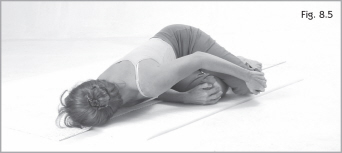


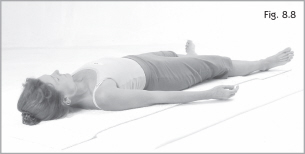
12. Continue the movement exploration on this side, experiencing the growing freedom in your hips and shoulders as the movement becomes more familiar. Keep the movement going long enough to sense how the left shoulder capsule becomes soft and pliable, allowing your head to roll over it without discomfort (fig. 8.7). Release your jaw and your tongue. Release all expressions on your face and enjoy the freedom of movement that comes in this unique position.
13. When you are ready, roll onto your back, stretch your legs and arms long, and experience the effects of the movement (fig. 8.8). Notice any pulsing, streaming, or tingling sensations that occur. Can you picture how the sacrum has released to move in cradle of the hips?
14. Do you notice the curves of your neck and low back being any closer to the ground than when you began? How do your shoulders contact the ground? Imagine how you have freed the low back and sacrum to move more freely when you are walking.
16. When you are ready, slowly begin your return, or continue into the following exploration.
Exploration 2: Reach and Roll
1. Lying on your back, bend both knees and bring them over your torso. Begin by moving into the Sacrum Release movement described in the previous exploration. Repeat a few times on each side and notice how much more familiar the movement is becoming as you recall the details of keeping the ankles in contact with each other and allowing your head to roll.
2. Holding your knees, roll over onto your right side. Pause for a moment. Now reach your left knee out over the right knee; continue to reach with the left knee, making a semicircle up toward the ceiling and all the way over to your left side (fig. 8.9). Let the right knee stay heavy on the ground until it has to come up in response to the left knee reaching and rolling over to your left side. The same is true for your head—leave your head on the right side until it is moved in response to the reaching and rolling of the left knee.

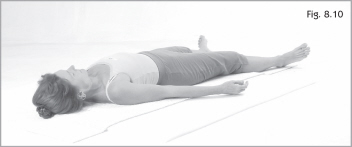
3. When you land on the left side, stay there a moment. Make sure both hands are firmly holding both knees. Now begin to reach the right knee out over the left knee, in a semicircular stretch up toward the ceiling and all the way back over to the right side. Now you have landed back on your right side.
4. Continue reaching with the knee that is on top and rolling all the way over to the opposite side. Repeat this movement several times, allowing the speed to be determined by the rhythm of your breath and the natural time it takes to discover how to propel the movement. Continue until the movement becomes familiar and effortless and you feel energized.
5. When you are ready, roll onto your back, stretch your legs and arms long, and experience the effects of the movement (fig. 8.10). Allow your breath to flow in and out without attempting to control or inhibit the breath in any way. Notice any pulsing, streaming, or tingling sensations that occur.
7. Notice the way you feel when your body is free to reach and roll when you propel the movement from the center of your pelvis. Make a mental reminder to notice how tall you feel and how your shoulders hang to your sides when you come up to standing; imagine the way your head will feel centered over your body.
8. Slowly begin your return, or continue to the integration exploration that follows.
Integration: Spiraling up to Sitting
1. From a position of lying on your back, bend both knees and bring them in over your torso. Grasp the knob of your right knee with your right hand, your left knee with your left hand (fig. 8.11).
2. Holding your knees, roll over onto your right side. Pause for a moment. Begin the Reach and Roll movement as in the previous exploration, reaching with your left knee out over the right knee. Continue to reach with the left knee, making a semicircle up toward the ceiling (fig. 8.12) and all the way over to your left side. Let the right knee stay heavy on the ground until it has to come up in response to the left knee reaching and rolling over to your left side. Leave your head on the right side until it is moved in response to the reaching and rolling of the left knee.

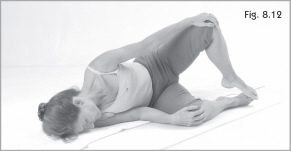
3. Continue reaching and rolling from side to side, allowing your breath to flow freely. As the momentum builds, begin to notice the precise place on the ground where your elbow touches the ground on each side.
4. Once you have developed an awareness of the contact your elbow makes with the ground, press into the elbow and see how this pressing begins to lift your torso up toward a sitting position (fig. 8.13). Continue reaching and rolling from side to side, pressing a little bit in the elbows to lift into sitting and then rolling back down and through to the other side.
5. After you experience the lift on each side that comes from pressing into the elbow, you are ready to power the movement with the top knee. You will still be using your elbow as a fulcrum to guide the movement, but this time let the momentum come from “throwing” the top leg up and over to bring you all the way into sitting. Once you are sitting, check to see that both knees are still bent at approximately right angles (fig. 8.14). Allow the “working” knee to reach further back, beyond the lower knee.
6. To come down, bring the working knee on top of the lower knee and roll back down to the floor, using your elbow as a pivot to guide you back down (fig. 8.15).
7. Explore reaching and rolling up to sitting from side to side until the movement becomes familiar and effortless.
8. This movement is a natural progression from the Sacrum Release and the Reach and Roll. Now your whole body is getting involved as you spiral up to sitting. Allow room for some confusion in the beginning. Go back to earlier stages of the Reach and Roll and allow the natural dynamics of your body to guide you into the movement. This movement can be exhilarating and a lot of fun. Enjoy the discovery process of how to make it a continuous flow from one side to the other. There are hundreds of ways to roll up to sitting from side to side. If this way does not work for you, invent a way to do it that feels natural and comfortable.
9. When you are ready, roll onto your back, stretch your legs and arms long, and experience the effects of the movement (fig. 8.16). Allow your breath to flow in and out without attempting to control or inhibit the breath in any way. Notice any pulsing, streaming, or tingling sensations that occur.
10. Now is the time to receive from the wisdom of your organism. Whatever your experience has been as you explore moving from your center in this interesting way, allow the results to be precisely as you are experiencing them. Suggest to your logical mind that each time you return to this movement, it will continue to integrate at deeper and deeper levels of effortlessness.

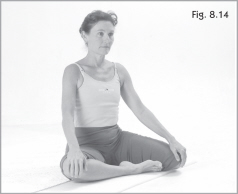
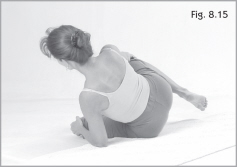

11. Now relax the muscle of your mind and allow all thoughts and thinking to dissolve into the steady stream of sensation that is flowing throughout your body. Allow the wisdom of prana to spiral you into the center of your being.
12. Before beginning your return, notice the way your body looks and feels when you are free to move from the center of your being. Suggest to your logical mind that you can return home to your center at any time and under any circumstances by simply recalling the way you feel in this moment. Suggest that you will be returning with the feeling of having had a deep, relaxing, rejuvenating sleep, and that you’ll be returning feeling fully energized, wide awake and ready to move on about your day.
13. Slowly begin your return by rocking your ankles from the inner anklebones to the outer anklebones. Roll your wrists from the inner wrist bones to the outer wrist bones. Roll your head from ear to ear. Bring up a good stretch. Allow your breath to deepen and let any sounds come out that happen spontaneously as you stretch.
14. Curl your knees into your chest, rock from side to side, and roll up into a sitting position. Is it any easier now to roll up to sitting? Open your eyes and notice whether your vision has altered in any way.
15. Slowly come up to standing. Do you feel any taller? How do your shoulders hang? Does your head feel like it is more centered over your body? Take a few steps around and notice the way your feet contact the ground. Notice the way your hips and pelvis move as you walk.
Before Moving On . . .
Locating the center of energy in your belly in the previous chapter prepared the foundation for the inquiries in this chapter that provide awareness for moving in different directions while remaining grounded in your belly. As you experiment with bringing this awareness of being centered in your belly into other aspects of your life, you might observe how often you find yourself returning to your belly center as a way of gathering greater concentration, perspective, and strength in all kinds of different situations. On the days that your yoga practice seems scattered or your priorities confusing, you might take a few minutes to return to Sacrum Release and Reach and Roll to regain your sense of center in the middle of it all.
Building on your capacity to roll up to sitting while remaining in contact with your center, the next chapter begins to explore greater opening and flexibility in the hip joints. Opening the hips for comfortable seated postures creates a flow of energy down into the legs and begins to balance the lower body with the upper body.